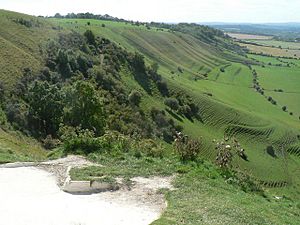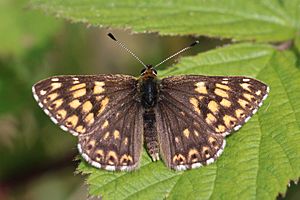Bratton Downs facts for kids
Bratton Downs is a special natural area in Wiltshire, England. It's about 396 hectares big, which is like 978 football fields! This area is protected because it has amazing plants, animals, and interesting landforms. It's officially called a Site of Special Scientific Interest (SSSI), which means it's super important for nature.
You can find Bratton Downs near the villages of Bratton and Edington. It's also about 5 kilometres (3 miles) east of the town of Westbury. This special place was first protected in 1971.
Most of Bratton Downs is covered in chalk grassland. This is a type of grassy area that grows on chalky soil. There are also some very old woods here. The land itself has cool shapes made by glaciers during the Pleistocene period, which was a long time ago during the Ice Age!
Contents
Where is Bratton Downs?
Bratton Downs SSSI covers several hills like Westbury Hill and Edington Hill. It also includes valleys called "combes," such as Combe Bottom. A long walking path called the Wessex Ridgeway goes right through this special area.
You might know the famous Westbury White Horse. This huge horse shape is carved into the side of Westbury Hill, right on the edge of Bratton Downs. Close by, there's also an ancient Iron Age fort called Bratton Camp. This fort sits on a hill about 225 metres (738 feet) high, just east of the White Horse. The fort is surrounded by Bratton Downs, but it's not actually part of the protected SSSI area itself.
What Plants Grow Here?
The main type of grass you'll see at Bratton Downs is upright brome. Another common grass is tor-grass. If sheep have grazed a lot in an area, you might find more sheep fescue and meadow oat-grass.
Many other interesting plants grow here too. These include blue sedge, spring sedge, and dwarf thistle. You can also spot salad burnet, burnet saxifrage, and devil's bit.
Some very special plants only grow in areas that haven't had fertilisers or weed killers used on them for a long time. These include common sainfoin, fern-leaf dropwort, and autumn lady's-tresses. You might also find chalk milkwort and fragrant orchid, which are beautiful flowers.
Trees and Bushes
On some slopes, you'll see patches of bushes and small trees growing. Common types include hawthorn, buckthorn, and blackthorn. You might also spot common holly, wayfaring tree, and ash trees. Whitebeam and field maple trees are also found here.
On the eastern side of the downs, there are two groups of ash and wych elm trees. These woods are very old. The plants growing on the ground in these woods are typical of ancient woodlands.
Amazing Animals of Bratton Downs
Bratton Downs is home to many different animals, especially birds and insects.
Birds You Might See
Birdwatchers have reported several interesting bird species here. You might spot the lesser whitethroat or the common linnet. The bright yellow yellowhammer and the tiny goldcrest also live here. Keep an eye out for the European green woodpecker too!
Butterflies and Other Insects
More than thirty different types of butterflies have been seen at Bratton Downs. Some of these butterflies are becoming rare in the United Kingdom. This is because their homes (habitats) are being destroyed.
Some of the rare butterflies found here include the marsh fritillary, the Duke of Burgundy, and the chalkhill blue. You might also see the pearl-bordered fritillary and the Adonis blue.
Other cool insects reported in the area include the uncommon burrowing bug Canthophorus dubius. You can also find the green forester, cistus forester, and scarce forester moths.



